Physical Address
304 North Cardinal St.
Dorchester Center, MA 02124
Vascular malformations (VMs) are developmental abnormalities of the vascular system. They should be differentiated from vascular tumors or hemangiomas because they have different etiologies, growth patterns, treatments, and outcomes. Malformations can involve any segment of the vascular tree: arteries, capillaries, veins, or lymphatics. High-flow arteriovenous malformations are associated with the shunting of large amount of arterial blood into the venous system. These lesions can have significant hemodynamic manifestations, such as venous engorgement, distal limb ischemia, and high-output cardiac failure. High-flow malformations are discussed in detail in Chapter 10 . This chapter focuses on low-flow venous vascular malformations (VVMs), which are seen most commonly in vascular clinics; many have a benign clinical course and require no special treatment. Many VMs are mixed, and some complex VVMs, like Klippel-Trenaunay syndrome (KTS), are associated with developmental abnormalities of other tissues, such as bone and soft tissue overgrowth or digital abnormalities.
Birthmarks and congenital deformities afflicting humanity have been described by historians and depicted by painters for centuries. Malan and Puglionisi were the first to attempt a classification of VMs (angiodysplasia), although the first practical guidelines for clinical classification and treatment were given by Szilagyi and colleagues. Rutherford also summarized the state of the art of VMs; of the multiple classifications published on these disorders, the Hamburg classification, in a revised form, is used most frequently. Although surgical excision has been recommended for local lesions, selective catheterization and embolotherapy as well as percutaneous sclerotherapy that have changed the multidisciplinary management of VMs over the last decades.
VMs are localized errors of angiogenic development, whereas hemangiomas are vascular tumors. Mulliken and Glowacki defined the endothelial characteristics and cell biology of VMs and vascular tumors. The term hemangioma should be reserved for vascular tumors alone; during the proliferative phase, they undergo growth and then usually resolution. The proliferative phase occurs during the first year, and spontaneous involution of hemangiomas is observed in 95% of cases by the age of 7 years. The female-to-male ratio is 5 to 1. Thirty percent of the hemangiomas are present at birth; the rest develop within the first 3 months of life. Endothelial hyperplasia is evident on biopsy specimens obtained from hemangiomas; these cells grow in tissue culture. In the proliferative phase, they incorporate [ 3 H]-thymidine and have an increased number of mast cells. Many patients with hemangiomas require no treatment at all.
In contrast, VMs are developmental, congenital abnormalities. There is increasing evidence that aberrant signaling at the molecular level results in dysfunction of normal proliferation, differentiation, maturation, and apoptosis of the vascular cells. Localized, superficial VVMs or capillary VMs (“birthmarks” of the skin and the mucosa) are the most frequent, but VMs also occur in the skeletal muscles, pelvis, chest, visceral organs such as the lungs, gastrointestinal system, and brain. The abnormal vascular channels are lined by a continuous endothelium and surrounded by an abnormal complement of mural cells. Ninety percent of these cells are present at birth, and the male-to-female ratio is 1 to 1. VMs show no endothelial proliferation, no cell growth is observed in tissue culture, the cells do not incorporate [ 3 H]-thymidine, and no mast cells have been observed in biopsy specimens. Clinically, no proliferation or spontaneous involution has been observed in VMs. The growth of the malformation is usually commensurate with the growth of the child, although hemodynamic factors (arteriovenous shunting, venous stasis) can accelerate growth and morbidity. Most low-flow VMs have a benign course, although complications such as bleeding, thrombophlebitis, skin changes, or infection may require treatment. High-flow arteriovenous malformations usually have a more ominous course and a worse prognosis. Treatment of these lesions, as discussed in Chapter 10 , is often required.
The classification, clinical presentation, and prognosis of VMs are largely dependent on the point at which there is an arrest or abnormality in the development of the vascular system; therefore, it is worthwhile to review briefly the normal development of the vascular tree of the limbs. Primitive vascular channels first appear in the third week of gestation. During its development, the vascular system undergoes differentiation through multiple stages. Stage 1 is the undifferentiated stage, with only a capillary network being present. Stage 2 is the retiform stage, when large plexiform structures can be seen. Stage 3, the maturation stage, includes development of large channels, arteries, and veins.
Vascular endothelial growth factor (VEGF) secreted by keratinocytes has been found to be responsible for inducing the penetration of capillary vessels into the avascular epidermis. This invasion and the subsequent arterial differentiation are also guided by VEGF originating from sensory nerves. A defective migratory response of endothelial cells to VEGF is the consequence of abnormal signaling of VEGF receptors. Malformations develop if the differentiation is abnormal and there is an arrest in the development of normal vascular tissue. It is indeed the persistence of the normal embryonic vascular system and any additional abnormal development that result in VMs.
Classification has been difficult because of the complex presentation and frequently mixed nature of VMs. The classification by Szilagyi and colleagues was based primarily on Woollard's stages of embryologic development: capillary malformations develop when there is an arrest in stage 1 ( Fig. 9.1 ). Although Szilagyi named them hemangiomas, these are not tumors but capillary or cavernous VM's. Microfistulous or macrofistulous arteriovenous malformations develop if there is an arrest in stage 2 (see Fig. 9.1 ). Persistence of large embryonic veins that develop in stage 3 is seen in patients with a persistent sciatic vein ( Fig. 9.2 ) or in those with large lateral veins of the leg ( Fig. 9.3 ). There are many mixed VMs owing to the involvement of several segments of the vascular system (capillaries, veins, lymphatics).
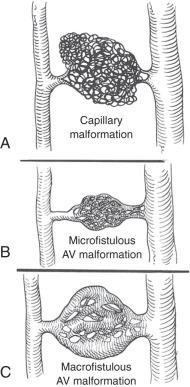
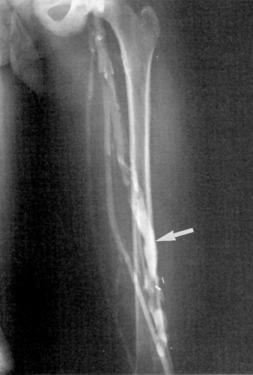
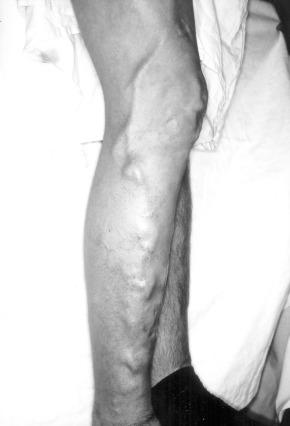
The International Society for the Study for Vascular Anomalies (ISSVA) classification distinguishes fast- and slow-flow VMs. A whole spectrum of malformations can be found between these two extremes.
The most recent recommendation is a combination of the modified Hamburg classification and the ISSVA classification, which divides the VMs into two major groups, low- and high-flow malformations ( Table 9.1 ). Low-flow malformation include VVMs as well as capillary, lymphatic, and combined lesions; high-flow VMs include arterial and arteriovenous malformations. Each malformation is then further classified for most categories into truncular or extratruncular forms, depending on the involvement of major axial vessels or branches of major arteries or veins.
| Malformation | Blood Flow |
|---|---|
| Arterial a | High flow |
| Arteriovenous a | |
| Venous a | Low flow |
| Lymphatic a | |
| Capillary | |
| Combined a | High flow or low flow |
a Each can be extratruncular (diffuse or localized) or truncular (with obstruction or dilation).
VVMs may be truncular; these include aplasia or obstruction, stenosis or hypoplasia, dilations, and aneurysms. Many patients with KTS have persistence of large embryonic veins or hypoplasia, dilation, or aneurysmal dilation of the deep veins of the limb ( Fig. 9.4 ). The estimated prevalence of deep venous anomalies in patients with predominantly venous malformations was 47% in one study. Phlebectasia, defined as dilated or aneurysmal deep veins, was the most frequent (36%), followed by aplasia or hypoplasia of the deep venous trunks (8%) and venous aneurysms (8%).
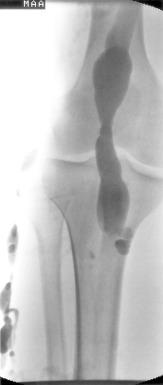
Extratruncular VVMs are the most frequent malformations; they can be diffuse ( Fig. 9.5 ) or localized. Most venous malformations are localized defects of vascular morphogenesis that manifest as single or multiple bluish-purple lesions, mainly in the skin and mucosa. Biopsy specimens show enlarged endothelial-lined vein-like channels with abnormal smooth muscle cells.
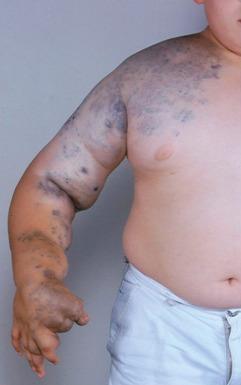
Capillary malformations, or port-wine stains, are frequent. These cutaneous lesions appear as red macular stains that darken over years ( Fig. 9.6 ). Capillary malformations are typical in patients with Sturge-Weber syndrome, KTS, and Parkes Weber syndrome.
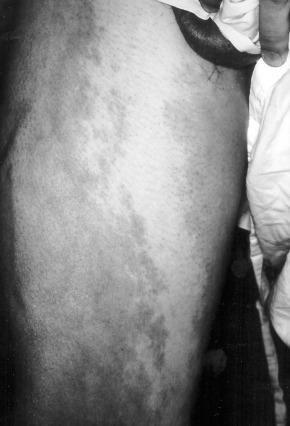
Lymphatic malformations have been found frequently in some series. The truncular form includes obstruction or hypoplasia causing congenital lymphedema, or dilation leading to valvular incompetence and rupture of lymphatics, causing chylous effusions or chylocutaneous fistulas owing to reflux of the chyle. Most lymphatic cysts and lymphangiomas are lymphatic malformations, and many venous malformations contain lymphatic tissue.
More than 70% of the VMs are mixed, and these frequently complex abnormalities can include arterial, capillary, venous, or lymphatic elements as well. Although the Hamburg classification discourages the use of eponyms, some terms are named after physicians who first described the conditions; these have been widely accepted and used. The list of clinical syndromes of VM includes Parkes Weber, Klippel-Trenaunay, Servelle-Martorell ( Fig. 9.7 ), Sturge-Weber, Rendu-Osler-Weber, von Hippel-Lindau, Kasabach-Merritt, Proteus ( Fig. 9.8 ), and Maffucci syndromes ( Table 9.2 .)
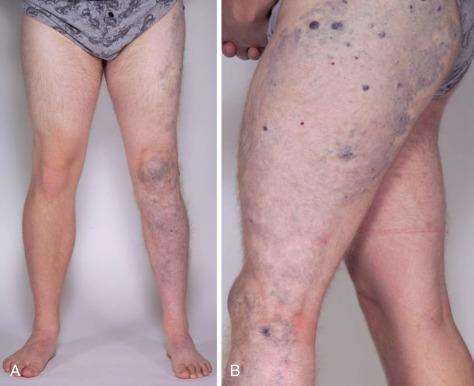
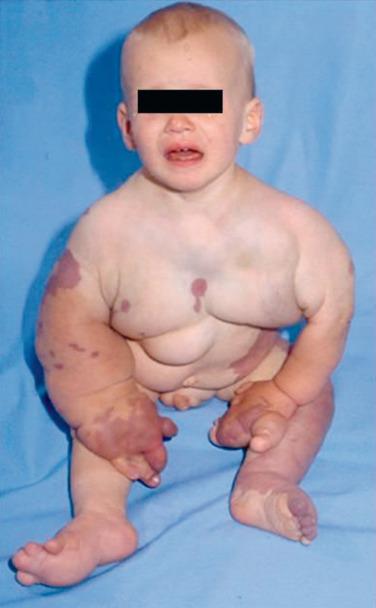
| Syndrome | Inheritance (Gene) | Type | Location | Characteristic Features | Treatment | Prognosis |
|---|---|---|---|---|---|---|
| Parkes Weber | Somatic mutations (RASA1) | AVM (intraosseal or close to epiphyseal plate), port-wine stain | Extremities, pelvis | Soft tissue and bony hypertrophy; varicosity (atypical); capillary and high-flow, high-shunt AVM | Observation, elastic support, embolization ± excision (localized lesions only) | Deep diffuse lesions have a poor prognosis |
| Klippel-Trenaunay | Somatic mutations (AGGF1) | Hemolymphatic malformation (VVM, lymphatic, and capillary malformation) | Extremities, pelvis, trunk | Soft tissue and bone hypertrophy; varicosities (lateral lumbar to foot pattern); capillary or venous vascular malformation, lymphatic malformation | Elastic support; Selective invasive Tx: epiphyseal stapling or selective excision or ablation of varicose veins, sclerotherapy | Usually good |
| Rendu-Osler-Weber (hereditary hemorrhagic telangiectasia) | Autosomal dominant (ENG, ACVRL1, MADH4) | Punctate angioma, telangiectasia, GI tract AVM | Skin, mucous membranes, liver, lungs, kidneys, brain, spinal cord | Epistaxis, hematemesis, melena, hematuria, hepatomegaly, neurologic symptoms | Transfusions; embolization vs. laser treatment ± excision | Good if bleeding can be controlled and no CNS manifestations |
| Sturge-Weber (encephalotrigeminal angiomatosis) | No (GNAQ) | CM | Trigeminal area, leptomeninges, choroid, oral mucosa | Convulsions, hemiplegia, ocular deformities, mental retardation, glaucoma, intracerebral calcification | Anticonvulsants, neurosurgical procedure | Guarded; depends on intracranial lesion |
| von Hippel-Lindau (oculo cerebellar hemangioblastomatosis) | Autosomal dominant (VHL) | Hemangioma | Retina, cerebellum | Cysts in cerebellum, pancreas, liver, adrenals, kidneys | Excision of cysts | Depends on intracranial lesion |
| Blue rubber bleb nevus | Autosomal dominant (TEK) | Cavernous venous malformation | Skin, GI tract, spleen, liver, CNS | Bluish, compressible rubbery lesions; GI bleeding; anemia | Transfusions, electrocoagulation, excision | Depends on CNS and GI involvement |
| Kasabach-Merritt | Autosomal dominant | Larger cavernous malformation | Trunk, extremities | Thrombocytopenia, hemorrhage, anemia, ecchymosis, purpura | Compression; transfusion of blood, platelets | Death from hemorrhage or infection |
| Maffucci (dyschondroplasia with vascular hamartoma) | Probably autosomal dominant (IDH1, IDH2) | AVM, cavernous lymphangioma | Fingers, toes, extremities, viscera | Enchondromas; spontaneous fractures; deformed, shorter extremity; vitiligo | Orthopedic management | Chance of malignancy 20% |
Genetic information on VMs has greatly increased in recent years. Most VMs are sporadic, but autosomal dominant inheritance has also been described. Genetic studies of families have resulted in the identification of mutated genes that have an important role in angiogenesis. These mutated genes in some patients encode tyrosine kinase receptors and intracellular signaling molecules. Vikkula and colleagues identified the endothelial-specific angiopoietin receptor TIE2/TEK, located on 9p21, as the cause of familial mucocutaneous VMs. Glomuvenous malformations (venous malformations with glomus cells, or glomangiomas) are similar to VMs; most of these lesions are inherited, and Boon and colleagues have identified the gene glomulin, a novel locus on the short arm of chromosome 1. Somatic mosaicism with gene mutations was identified in Proteus syndrome (AKT1) , KTS (AGGF1) , Mafucci syndrome ( IDH1 and IDH2 ), Sturge–Weber syndrome (GNAQ) , and CLOVES syndrome (PIK3CA) (see Table 9.2 ).
Port-wine stains have also been observed in families, and a genetic susceptibility for these capillary malformations has been suggested. Eerola and colleagues identified a large locus, CMC1, on chromosome 5q. These authors used genetic mapping to identify a positional candidate gene, RASA1 ; heterozygous inactivating RASA1 mutations were detected in families manifesting capillary malformations. Of interest, arteriovenous malformation, arteriovenous fistula, or Parkes Weber syndrome were also documented in all the families with this mutation.
Primary congenital lymphedema can be hereditary (Milroy disease), whereas late-onset primary lymphedema was also observed in multiple members of the same families (Meige disease). Congenital lymphedema has been linked to chromosome 5q35.3, where the VEGFR3 gene (VEGF receptor 3) is located. It is likely that congenital lymphedema is caused by a lack of sufficient signaling via the VEGFR3 receptor.
VMs occur in approximately 1.5% of the population. Published series of VMs seen at referral centers suggest that predominantly VVMs are the most common vascular anomalies; they are estimated to occur in between 1 of 5000 and 1 of 10,000 childbirths. VVMs are certainly the most frequent that require medical attention. Still, it is likely that capillary malformations or port-wine stains of the skin and mucosa are the most frequent VMs, occurring in 0.3% of childbirths. Among 797 patients with VMs reported by Lee and colleagues, 40% had predominantly lymphatic malformations.
Patients with VVMs are frequently asymptomatic, and a birthmark of the skin or the mucosa is a cosmetic deformity only. However, patients who seek consultations by vascular surgeons may have a complex presentation or juvenile varicosity, and the limbs or pelvis may have extensive involvement by the malformation. Clinical presentations include varicose veins (see Fig. 9.3 ), limb edema or overgrowth ( Fig. 9.9 ), port-wine stain, or digital anomalies ( Figs. 9.10 and 9.11 ). The varicose veins are usually atypical, lateral, or suprapubic, although occasionally a varicosity may involve the great saphenous vein and its tributaries. Bleeding or leakage of lymph fluid from VVMs is not infrequent. Thrombophlebitis, cellulitis and lymphangitis, skin lesions, induration, pigmentation, and ulcerations can be signs of chronic venous insufficiency. Many of the patients with mixed lesions have associated lymphedema. Patients with pelvic involvement may exhibit hematuria and rectal bleeding. Any patient with varicose veins or port-wine stains with a longer or shorter limb could also have an underlying VM. Patients with primary or secondary lymphedema have limbs of identical length.
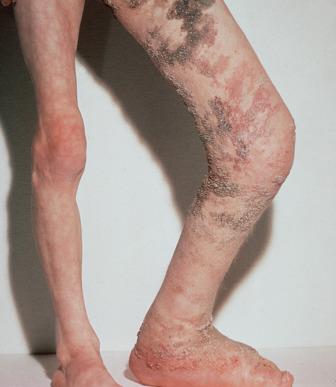
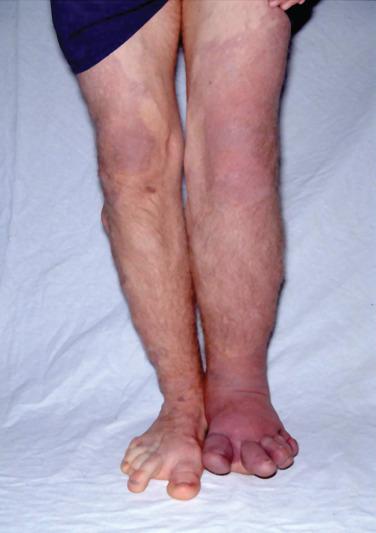
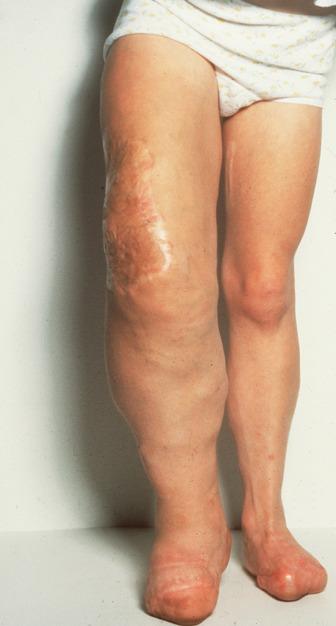
Low-flow VVMs should be differentiated from high-flow arteriovenous malformations based on the physical exam alone. If an arteriovenous malformation is present, the affected limb or pelvis may harbor a mass that is pulsatile; it may have a systolic-diastolic bruit and a palpable thrill that can be easily appreciated when the hand is placed over the affected area. The distal pulses are usually diminished and evidence of venous congestion distal to the fistula is frequent.
Diagnostic tests should focus on evaluation of the type and extent of the malformation. The presence or absence of any arteriovenous shunting must also be established. Physical examination of limb and pelvic lesions should be complemented by segmental systolic limb pressure measurement and establishment of the ankle-brachial index. Pulse volume recording is helpful in patients with arteriovenous malformations Placement of a tourniquet on a limb with a high-flow, high-shunt arteriovenous malformation and occlusion of the fistula will increase systolic blood pressure, which is followed by slowing of the heart rate because of a vagal response in the baroreceptors in the aorta and carotid arteries (bradycardia, or Branham sign). Duplex scanning will confirm other hemodynamic consequences of an arteriovenous shunt, such as low-resistance waveform in the arteries and pulsatile flow in the veins. Duplex scanning will also establish patency of the superficial and deep veins and other abnormalities, including an aneurysm or arterial dilation, hypoplasia, or valvular incompetence of the superficial or deep veins.
Become a Clinical Tree membership for Full access and enjoy Unlimited articles
If you are a member. Log in here